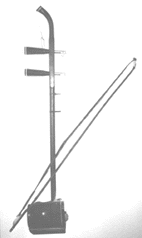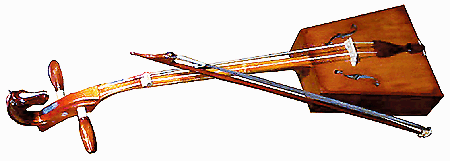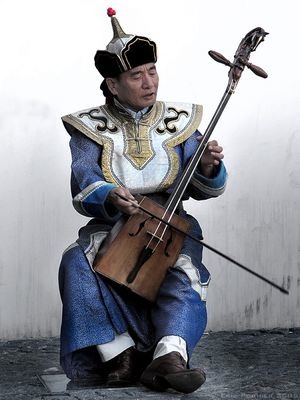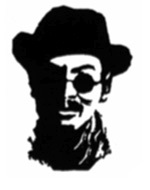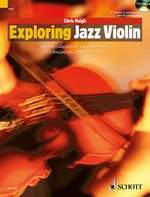
MENU TO FIDDLE STYLES:
Chinese fiddle
The Erhu
One of the most beautiful and haunting sounds in Chinese music comes from a type of fiddle called the erhu (pronounced are-who). The ancient ancestor of both violin and erhu is thought to have appeared in Persia some 3.000 years ago. A slow migration west lead to the first violins in Europe; the route east along the Silk Road gave rise to a family of instruments collectively called the Hu-Qin. They were brought by barbarians into China in the Han Dynasty (140 BC); the erhu itself was first described in the Song Dynasty (AD 420-79).
It is a two-stringed instrument, played sitting down and held vertically, with the body resting on the knee. The strings were originally of silk but are now usually steel. The small 6-sided body has a wooden resonator and a belly of python skin; the hardwood neck is long and narrow, and the hairs of the bow pass horizontally between the two strings, which are usually tuned to D and A. The horsehair bow rests on the body of the instrument and points inwards, at right angles to the normal angle of a violin bow.Because both sides of the bow are used, both sides must be rosined.
Unlike on a western fiddle, the strings are not pressed down onto a fingerboard; exceptional bow control is needed and the finger pressure on the strings is critical. Both strings are
fingered simultaneously, but the direction of pressure on the bow allows one or the other string to be sounded. The resulting tone is close to that of the violin, though more nasal in quality. Vibrato and trills are widely used, and the instrument is capable of great sensitivity and can be hauntingly evocative and soulful.
Perhaps because of its supposed barbarian origins, the erhu has traditionally been seen as an instrument of the lower classes with a lower status than, for example the Qin (a type of zither)- the traditional instrument of intellectuals.The erhu features regularly in silk and bamboo ensembles; an elaborate but quite accessible form of Chinese folk music, alongside various bamboo wind instruments, and plucked strings such as the Pipa (lute) and Yang Qin (dulcimer). Such music is played at village ceremonies and at informal "jam sessions" in tea houses. It is also heard as an accompanying instrument in Chinese Opera, an ancient form of highly stylised musical drama, and in composed classical music. There are around a dozen close relatives of the erhu within China and in other parts of the Far East. The erhu banhu, for example, has a wooden top rather than a snakeskin membrane, and the Sihu, from Mongolia, has two pairs of strings and uses a remarkable double bow with two tiers of hair. It is only in recent years that the erhu itself has become prominent in Chinese music and has been accepted both as an orchestral section instrument (including bass, tenor and alto versions) and as a featured solo instrument.
Morin Khuur
The morin khuur (or Morin Khur), also from Mongolia, is a rectangular bodied fiddle with a carved horse's head and strings made of thick strands of silk or horse hair. The two strings are designated as the male (made from 130 hairs from a stallion's tail) and the female (made from 105 hairs from a mare's tail); the strings were traditionally tuned a fifth apart, but are now more often a fourth apart. On the left hand the nails of the first and second finger press down from above, while the third and fourth press up from underneath. The instrument produces a deep, throaty sound not unlike the striking Tuvan singing style, and also said to be reminiscent of a horse neighing. Unlike the erhu, the bow does not pass between the two strings. The Morin Khuur is Mongolia's national instrument, and much of the music played on it relates to horse riding in some way, particlarly in the galloping rhythms and the whinnying sound that can be produced from the strings.
Morin
Khur
Dancing by candlelight
Much of the credit for the erhu's recent popularity must go to Liu Tian Hua. After a classical music education in the early part of the 20th Century he started to learn the erhu from monks and folk musicians; this was at a time when anyone seen playing an erhu in the Beijing conservatoire would probably have been ejected forthwith!
Liu Tian Hua
He collected and transcribed many folk tunes, and began composing for the instrument himself, honing and developing his technique, and elevating the instrument to the professional and academic status that it now enjoys.
Among his many compositions, before his death in 1932, were nocturnal peace, dancing by candlelight, meditation in retirement and song of birds on a distant mountain. The reflective and descriptive nature of these titles is typical of much of Chinese music, which has deep and ancient bonds with poetry, art, and the timeless landscape of China.
Cultural Revolution
During Mao's Cultural Revolution (1966-76), most Chinese musicians and intellectuals were forced to work in the fields, or simply shot, resulting in in the temporary destruction of most Chinese culture. It is a double irony that several prominent erhu players found themselves starting the erhu as an indirect result of the surrounding chaos. Tan Dun learned from his grandmother whilst his white-collar family laboured among the rice; he rapidly developed from playing in village ceremonies to working in the local opera, and finally to orchestral composition using contemporary western techniques.
Xu Ke was forced to learn when his parents decided that, to keep him safe from the revolutionary violence outside he was virtually locked up at home; they gave him an erhu to keep him busy. He now has a mission to "bring the erhu to the world", and incorporates aspects of western playing style and repertoire into his performances. The front rows of his audiences are often filled with baffled violinists trying to work out how he can play the Pagganini variations with only two strings.
The Last Emporer
The idea of bringing western classical "party pieces" into the repertoire in order to bridge the cultural gap and attract the attention of a wider audience has been taken up by many other players. Jiang Jian Hua, born into a family of ten erhu players (what were the parents thinking of!) did her career no harm when she played Zigeunerweisen to Von Karajan in 1976. She features heavily on the soundtrack to Bernado Bertolucci's film The Last Emporer, and is considered one of the world's leading players.
Rong Chun Zhao is known for transcribing the Hora Staccato, whilst George Gao was the first to play Carmen on the erhu. These are considerable feats of technique and ingenuity, considering the physical limitations of the instrument. Gao is also known for incorporating the erhu into jazz, new age and pop compositions. Look out for his tune Little Cabbage!
George Gao Many of these professional players have settled outside China, where they can find greater commercial opportunities and a wider musical horizon. Dr. Sin Yan Shen, for example, is resident in the US, where he introduces American audiences to Chinese traditional music with his Silk and Bamboo Ensemble and his Chinese Classical Orchestra.
Links:
Return to fiddlingaround.co.uk homepage
